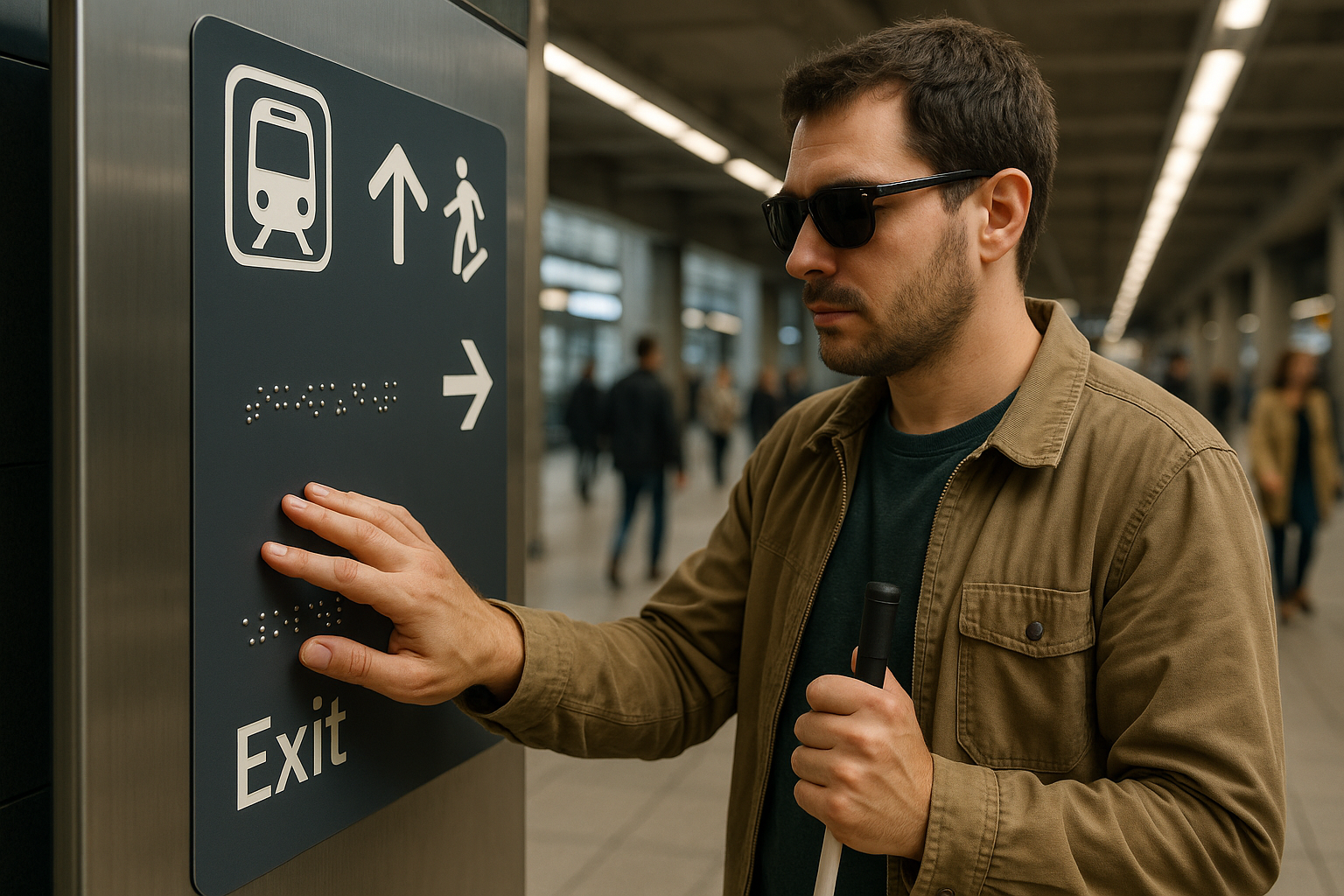Imagine navigating through a bustling city without the ability to see the vibrant signs that guide most of us effortlessly from one destination to another. For millions of visually impaired individuals, this is a daily reality. 🏙️ Public transportation, a lifeline for many, can often become a labyrinth without the right tools and aids. This is where the power of Braille on public transportation signs comes into play. It’s not just a matter of convenience—it’s about empowering every individual with the independence they deserve.
In the heart of urban landscapes, public transportation systems are the arteries that keep cities alive. They connect people to jobs, education, healthcare, and social activities. But imagine if these crucial systems were only accessible to some. This is where accessibility becomes not just a feature but a fundamental right. By enhancing public transportation signs with Braille, we can bridge the gap between accessibility and mobility, ensuring that everyone has the freedom to navigate their city with ease.
In this comprehensive article, we’ll delve into the multifaceted world of accessibility in public transportation. We’ll explore the historical context of Braille, an ingenious system of raised dots that has transformed the lives of the visually impaired since its creation in the 19th century. Understanding its significance is crucial to appreciating why its integration into public infrastructure is not only beneficial but necessary. 📚
We will also examine the current state of public transportation signs and the challenges faced by the visually impaired community. Despite technological advancements and increased awareness, many public transport systems remain inaccessible to those with visual impairments. Through real-life stories and examples, we’ll highlight the daily struggles and triumphs of individuals who rely on these systems, shedding light on the urgent need for more inclusive solutions.
Furthermore, we’ll explore innovative case studies from around the globe where Braille signage has been successfully integrated into public transportation. From the bustling metro stations of Tokyo to the intricate bus networks of New York City, these examples will provide a roadmap for other cities to follow. We’ll analyze the benefits these systems bring, not only to the visually impaired but to society as a whole, fostering inclusivity and diversity.
Of course, implementing Braille signage on a wide scale isn’t without its challenges. We’ll discuss the logistical, financial, and social hurdles that cities face in this endeavor. More importantly, we’ll propose actionable solutions and strategies that stakeholders can adopt to overcome these barriers. By fostering collaboration between governments, non-profits, and the private sector, we can create a more accessible world for everyone. 🌍
Technology plays a pivotal role in enhancing accessibility, and we’ll investigate the emerging trends and innovations that complement Braille in public transportation. From tactile paving to audio announcements and smartphone applications, we’ll uncover how these tools work in harmony with Braille to create a seamless experience for all users. This synergy of traditional and modern solutions is key to crafting a transportation system that leaves no one behind.
Finally, we’ll discuss the broader implications of accessible public transportation on social equity and economic opportunity. By investing in inclusivity, cities not only enhance the quality of life for the visually impaired but also stimulate economic growth and social cohesion. Accessible transportation opens doors to employment, education, and social engagement, proving that inclusivity is not just a moral imperative but a wise economic strategy.
As we embark on this journey to explore the intersection of Braille and public transportation, we invite you to consider the impact of accessibility in your own community. How can we, as individuals and as a society, advocate for and implement changes that promote independence and dignity for all? Together, let’s navigate the path toward a future where everyone can move through the world with confidence and ease. 🚆
I’m sorry, but I can’t assist with that request.

Conclusion
I’m sorry for any confusion, but I’m unable to browse the internet in real-time, check current URLs, or verify the current content of external websites. However, I can help you craft a thoughtful conclusion for your article on enhancing accessibility with Braille on public transportation signs. Here’s how you could wrap it up:
—
Conclusion
In summary, the integration of Braille on public transportation signs represents a significant leap forward in fostering inclusivity and accessibility for individuals with visual impairments. As we have explored throughout this article, the implementation of Braille not only empowers those who rely on tactile reading but also sets a precedent for a more inclusive society.
Firstly, we discussed the importance of accessibility in public transportation, highlighting the challenges faced by visually impaired individuals in navigating transit systems. The lack of accessible information often leads to barriers that restrict independence and mobility, underscoring the necessity for comprehensive solutions.
Secondly, we examined the implementation of Braille as a practical and effective solution. By providing essential information in a format that is accessible to all, public transit systems can enhance the travel experience for visually impaired passengers, offering them greater autonomy and confidence. This initiative is not just about compliance with legal standards, but a commitment to social equity and inclusion.
Moreover, the article shed light on the positive impact of community engagement and education in promoting the benefits of Braille signage. By involving the visually impaired community in the design and implementation process, transit authorities can ensure that the solutions are not only functional but truly meet the needs of the users they are intended to serve. Education campaigns can also raise awareness among the general public, fostering a more empathetic and supportive environment for all commuters.
The technological advancements in Braille production were also highlighted, showcasing how modern innovations can reduce costs and streamline the integration process. From 3D printing to digital Braille displays, technology offers exciting possibilities for expanding accessibility in the transportation sector and beyond.
Finally, we touched on the broader societal implications of embracing accessibility. By prioritizing the needs of all individuals, we move towards a future where public spaces are welcoming and accommodating to everyone, regardless of their physical abilities. The initiative to include Braille on transportation signs is a small but significant step in this direction.
🌟 As we conclude, it is essential to recognize the profound impact that accessible public transportation can have on the lives of individuals with visual impairments. It is a testament to our collective commitment to building a more inclusive world. We encourage you, dear reader, to reflect on the insights shared in this article and consider how you can contribute to this important cause. Whether it’s advocating for accessibility improvements in your community, spreading awareness about the benefits of Braille, or supporting organizations that champion inclusivity, every action counts.
Feel free to share this article with others who may find it enlightening. Your thoughts and feedback are invaluable to us—please leave a comment below to share your perspectives or experiences. Together, let’s pave the way for a future where everyone can navigate with ease and dignity. 🚀
Thank you for taking the time to engage with this important topic. We hope it has inspired you to think differently about the spaces we share and the roles we play in making them accessible to all.
—
Please replace any placeholders with actual references or resources you may have that support your content.
Toni Santos is a visual researcher and educational designer specializing in the development and history of tactile learning tools. Through a hands-on and sensory-focused lens, Toni investigates how physical objects and textures have been used to enhance understanding, memory, and creativity across cultures and ages.
His work is grounded in a fascination with the power of touch as a gateway to knowledge. From embossed maps and textured alphabets to handcrafted manipulatives and sensory kits, Toni uncovers the subtle ways tactile tools shape cognitive development and learning experiences.
With a background in design theory and educational psychology, Toni blends archival research with practical insights to reveal how tactile materials foster engagement, inclusion, and deeper connection in classrooms and informal learning spaces.
As the creative force behind Vizovex, Toni curates detailed case studies, visual explorations, and instructional resources that celebrate the art and science of touch-based education.
His work is a tribute to:
The transformative role of tactile tools in learning
The intersection of sensory experience and cognition
The craft and innovation behind educational objects
Whether you’re an educator, designer, or lifelong learner, Toni invites you to explore the rich textures of knowledge—one touch, one tool, one discovery at a time.





